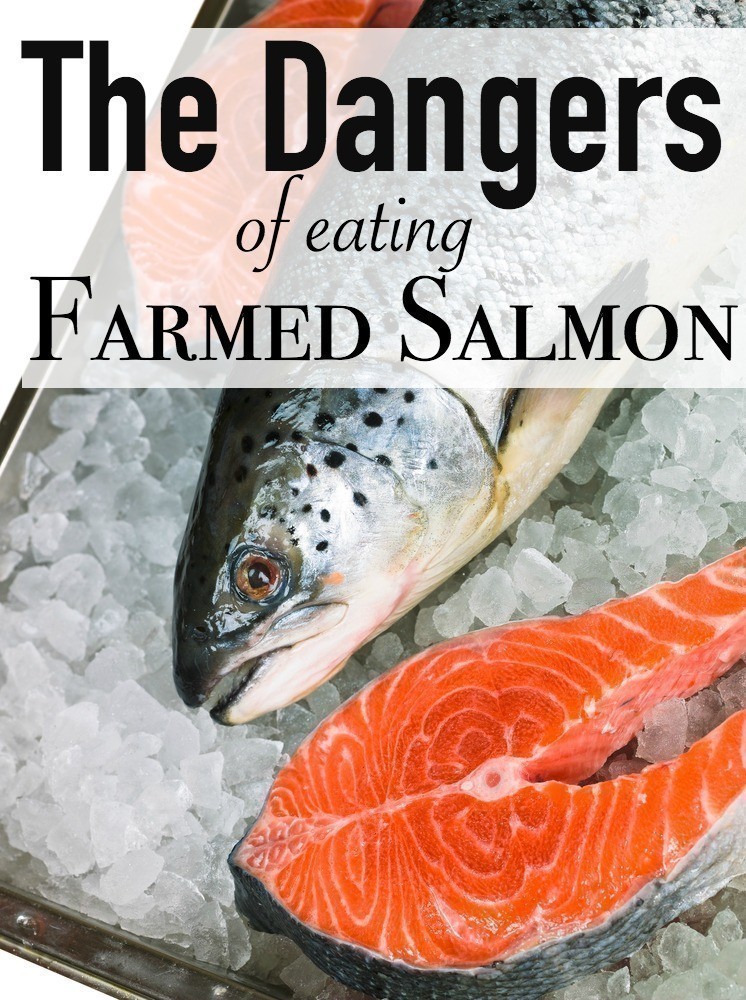
Have you heard that fish is a healthy option? It is, but it also isn’t – it’s only partially true. For many it’s always an assumption that it’s an inexpensive, healthy alternative food to eating heavier amounts of beef .. and is great for those that want to lose weight. In addition, it’s rich in Omega 3’s … and recommended 1-2 times per week for better health.
What makes the biggest difference in fish (much similar to any food) is where it comes from – and just like knowing where your Beef comes from, it’s always just as important to know where your Fish comes from, too.
We love Fish, I love Salmon – but as much as I LOVE it, it’s important to know more about it so you can make the best choice for your health.
Did you know that over 60% of the fish eaten in the U.S. is farm-raised? (Src)
Fish can be classified into wild caught or farmed (much like beef can be categorized into Confined Animal Feing Operations (CAFO) or Pasture Raised).
Now, before we go any further… we aren’t telling you to avoid eating fish.
That’s just simply NOT our intent.
Cheap isn’t always better – and just because the grocery store has it on sale doesn’t mean you should automatically assume it’s great for your budget and diet.
Reasons to Avoid Farmed Salmon
We are always encouraged to eat more fish for their health giving Omega 3’s. Since Wild Fish costs more, we always assume we have a great deal in farm-raised fish – after all, it’s cheaper, right?
I try to eat at least one serving a week, sometimes two – but it’s not always cheap to buy GOOD salmon, so we do what we can.
While Wild Salmon may feed mostly on krill (which gives them their red color), man raised fish are fed pellets containing high concentrations of fish. Krill that are eaten by Salmon are toxin free – but the concentration of the pellets given to farm raised salmon increase PCB levels.
Most of the farm raised fish are also fed genetically modified foods – and their color is naturally “gray” as a result of being confined, and eating a poor diet. To make it look pink, they are fed chemical dyes.
One thing that man cannot do, however, is raise Omega 3 levels in farmed fish – because those levels are ONLY produced in wild fish. Some things are better when left to Mother Nature – agree?
Here are some disturbing facts about Farmed Salmon.
#1 – Fish Farms produce supermarket protein with antibiotics, pesticides and extremely low levels of nutrients.
#2 – They are given antibiotics to ward off disease from crowded conditions, much like cattle in confined animal feeding operations. They are also treated with pesticides to combat sea lice. These sea lice circulate in the ocean water – and they can do some serious damage to wild salmon – killing up to 95%.
#3 – Polychlorinated Biphenyls, a cancer causing chemical, is also found in farm raised salmon at 16 times the regular rate of wild salmon and has recently been found by the Environmental Working Group after studies were done in Canada, the UK and Ireland. (Src)
#4 – Dibutyltin is ALSO another chemical – found in farmed raised mussels, that can interfere with your immune system and cause inflammation that contributes to allergies, asthma, obesity and other immune disorders. It is the same chemical found in PC plastics.
#5 – Dioxins are also higher in farmed fish – more than 11 times than non-farmed raised salmon. Dioxins are a toxic compound produced as a byproduct in manufacturing processes, and herbicide production – in other words, they are byproducts of industrial practices. They are produced through waste incineration, & burning of trash. Not only are they highly toxic, the body can’t get rid of them easily – therefore they stay in the body with a half life of 7-11 years .. in your fat cells. Those Dioxins can cause problems with your reproductive system, immune, nervous systems & more. (Src)
#6 – Are fed antibiotics at levels that are drastically higher than any other livestock. Think that’s not a big deal? It is – because they are therefore passed along to you when you consume them, therefore making you more resistant to antibiotics.
#7 – Are confined into small areas – which not only confine their movement but also increase the chances for disease. Since they are in crowded areas, they are given more antibiotics to ward of disease – see above.
That’s not it either – we could go on and on with farmed fish – but we’ll stop there.
How do you Avoid Farmed Salmon?
If you find yourself eating Salmon at restaurants often, be aware that 90-95% of the Salmon is farmed – and sometimes it is mis-listed on the menu. I love having Salmon at restaurants, but it is alarming to know that your meal could potentially be causing more harm than good.
Here are some tips to help you determine whether or not the salmon you are eating is Wild-Caught seafood.
- If you buy canned Salmon, look for Alaskan Salmon (which is NOT permitted to be farmed)
- Sockeye Salmon also cannot be farmed – therefore it’s usually safe and considered Wild Caught.
- Always try to stay clear of Atlantic Salmon – it comes from fish farms and is factory farmed fish
- If you find yourself at a restaurant, look for Wild Alaskan on the menu ~ if you spot the term “Wild”, then it’s a red flag, as the term Wild is often misused (just about as much as the word “Natural” is used on foods in the grocery store)
- If you buy Salmon at the grocery store, always look to Sockeye OR Wild Alaskan Salmon – if your Salmon is NOT labeled, ask the frozen food manager or meat counter. If they are unable to tell you what the salmon is, then that should send up flags that it is farmed salmon.
In the end, it’s best to stick with what you know is best – whether that be grass fed beef, raw dairy, and organic produce and foods free of pesticides and genetically modified organisms. You’ll stay healthier and experience better health benefits long term.



